Abstract
The steady-state responses of respiration, measured as integrated phrenic nerve activity, to hypercapnic acidosis of the medullary extracellular fluid (e.c.f.) and to metabolically generated acidosis were compared in paralysed, vagotomized and glomectomized cats. E.c.f. hydrogen ion concentration [( H+]) was measured directly by means of a small (2 mm diameter) pH electrode placed on the ventral medulla. The results in ten cats show that changes of medullary e.c.f. [H+] were linearly related to changes of end-tidal PCO2 both before (r = 0.999) and after (r = 0.996) development of metabolic acidosis. There was a curvilinear relation between hypercapnic e.c.f. [H+] changes and the respiratory response that reflects progressive saturation of a central neural pathway between the chemoreceptors and the respiratory controller. This relation was similar in form both before and after development of metabolic acidosis. When acidosis of metabolic origin was present, apnea occurred with only small decreases of CO2 despite a high [H+]. The respiratory responses to the same e.c.f. [H+] change were only about one-half as large when they were generated metabolically as when they were generated by raising PCO2. Both exogenously induced metabolic acidosis (HCl infusion) and endogenous acidosis yielded similar results. We conclude that the e.c.f. [H+] does not represent the unique stimulus to the central chemoreceptors. We discuss several alternate mechanisms for the action of CO2 and [H+] on central chemoreceptors but none can be considered definitive at the present time.
Full text
PDF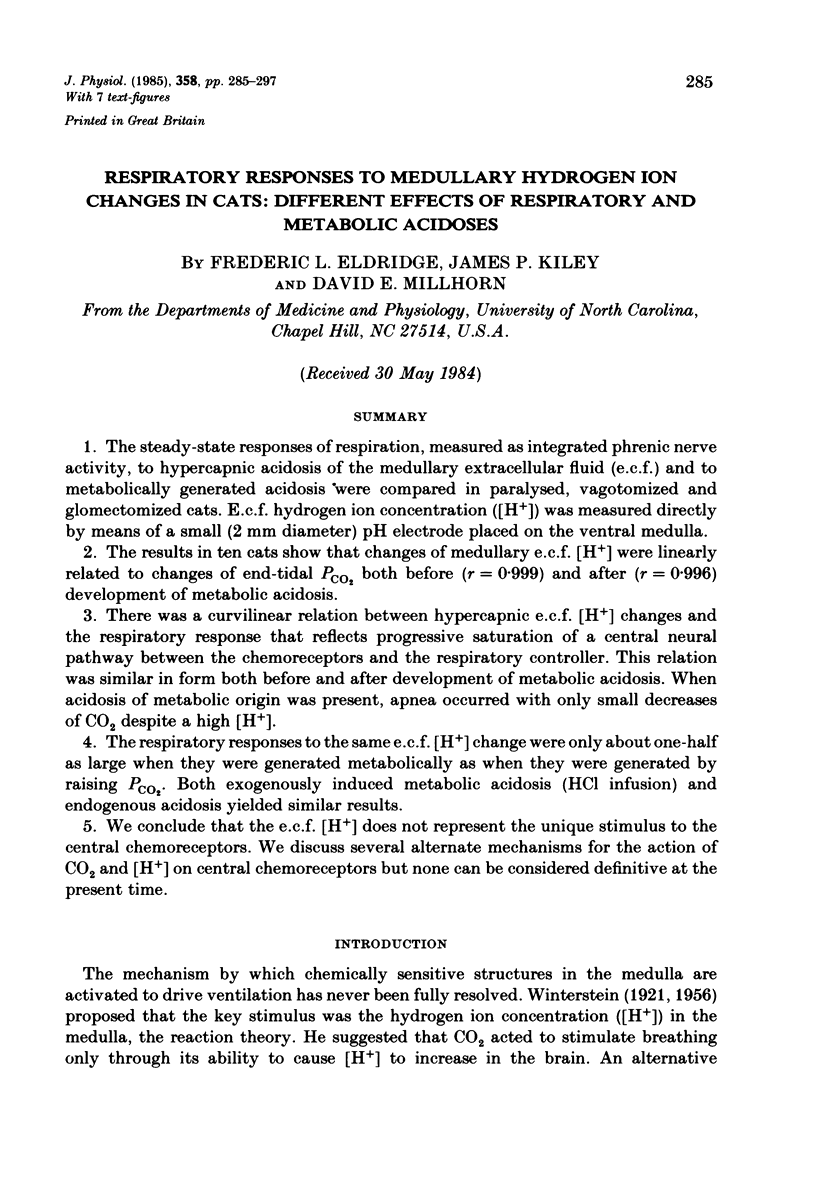
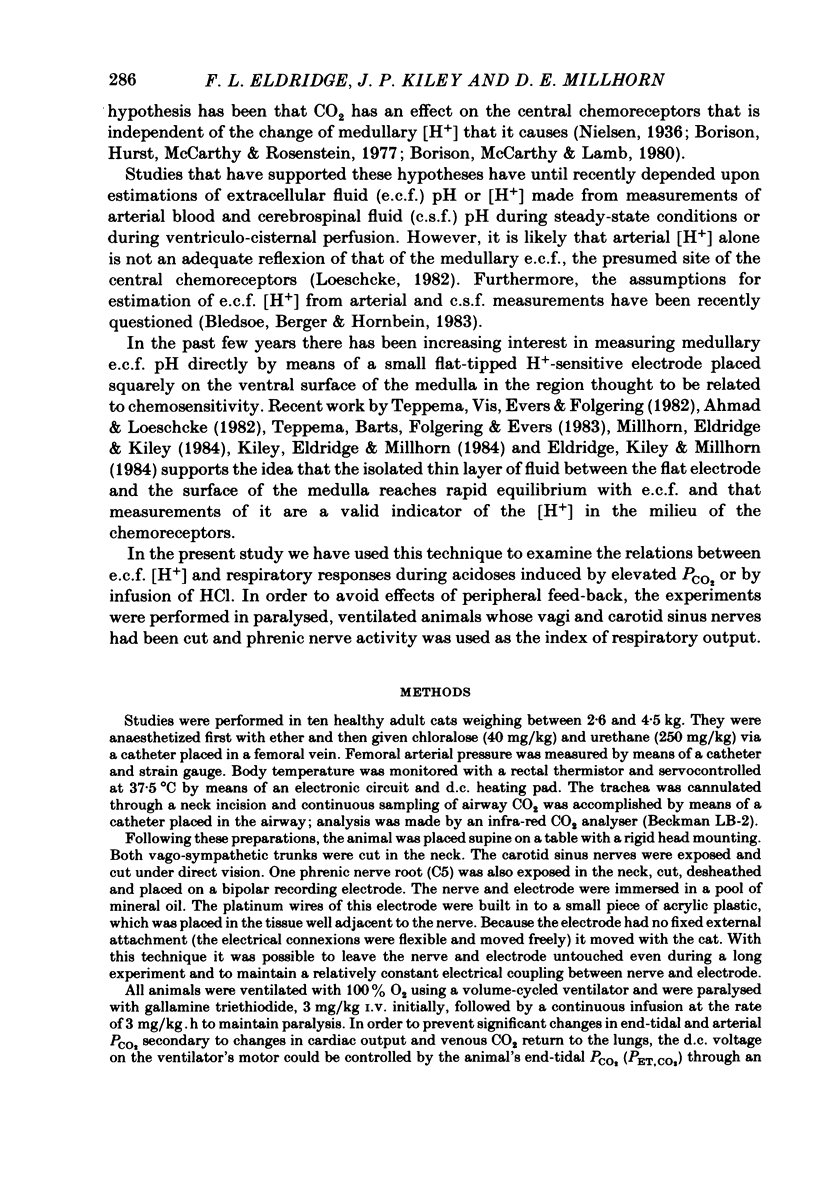
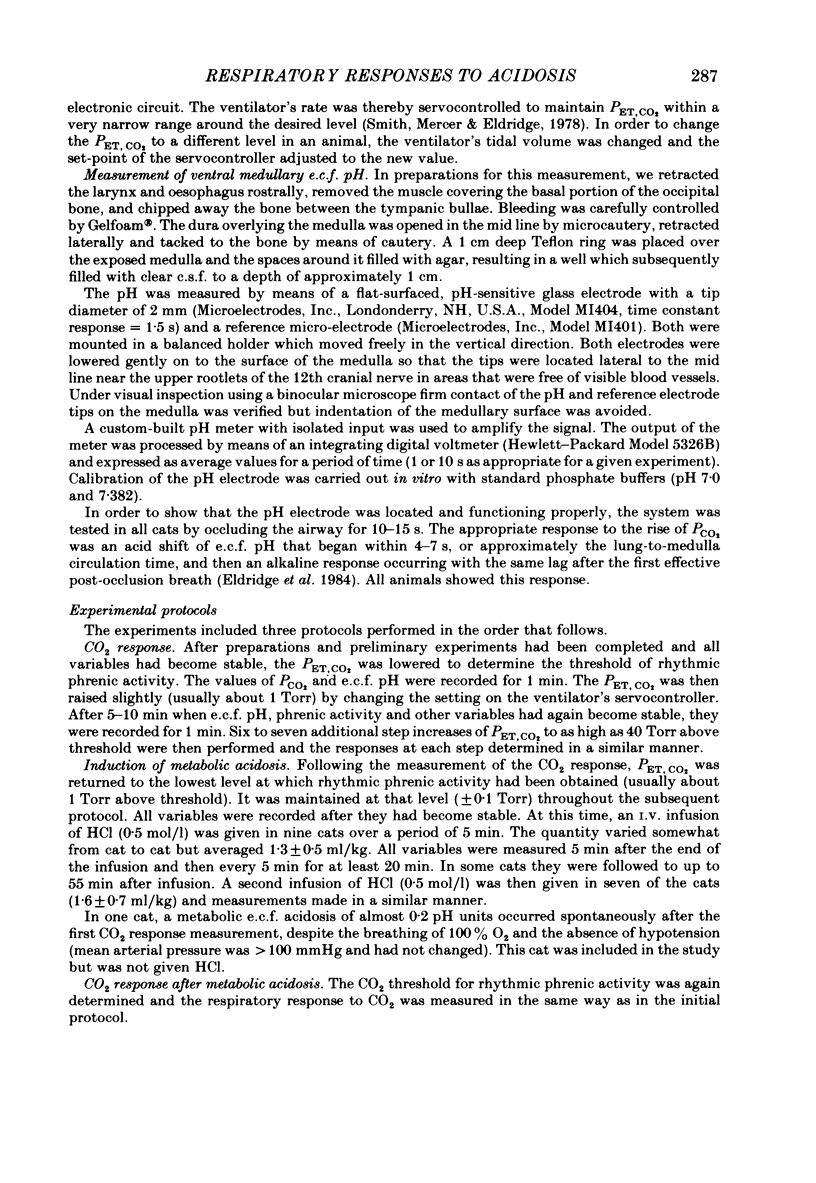
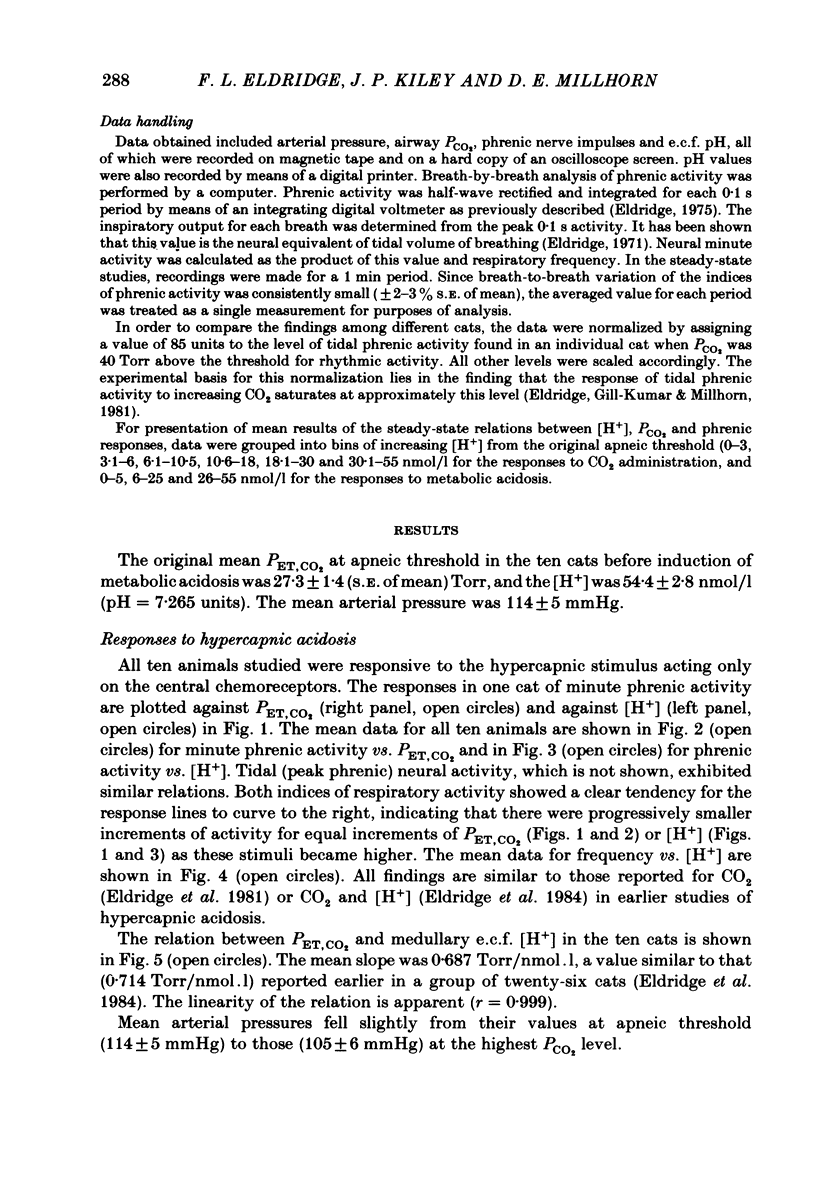
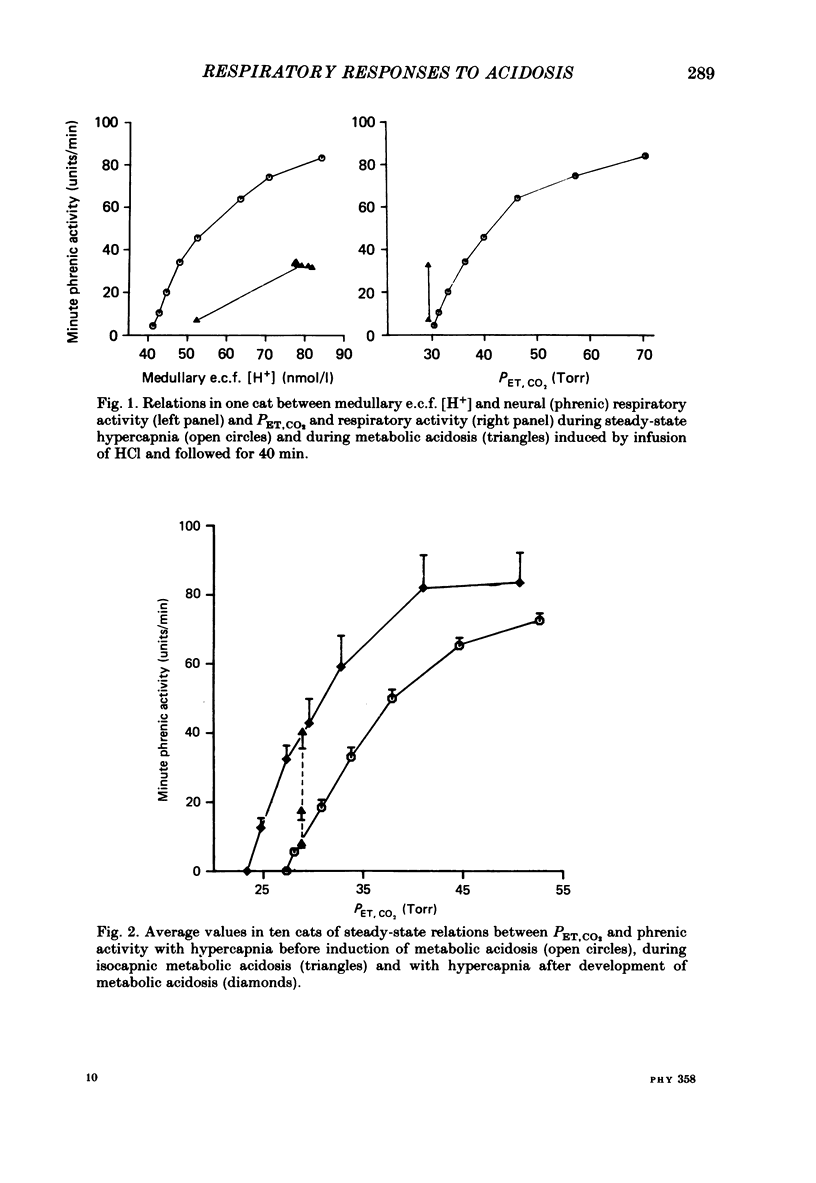
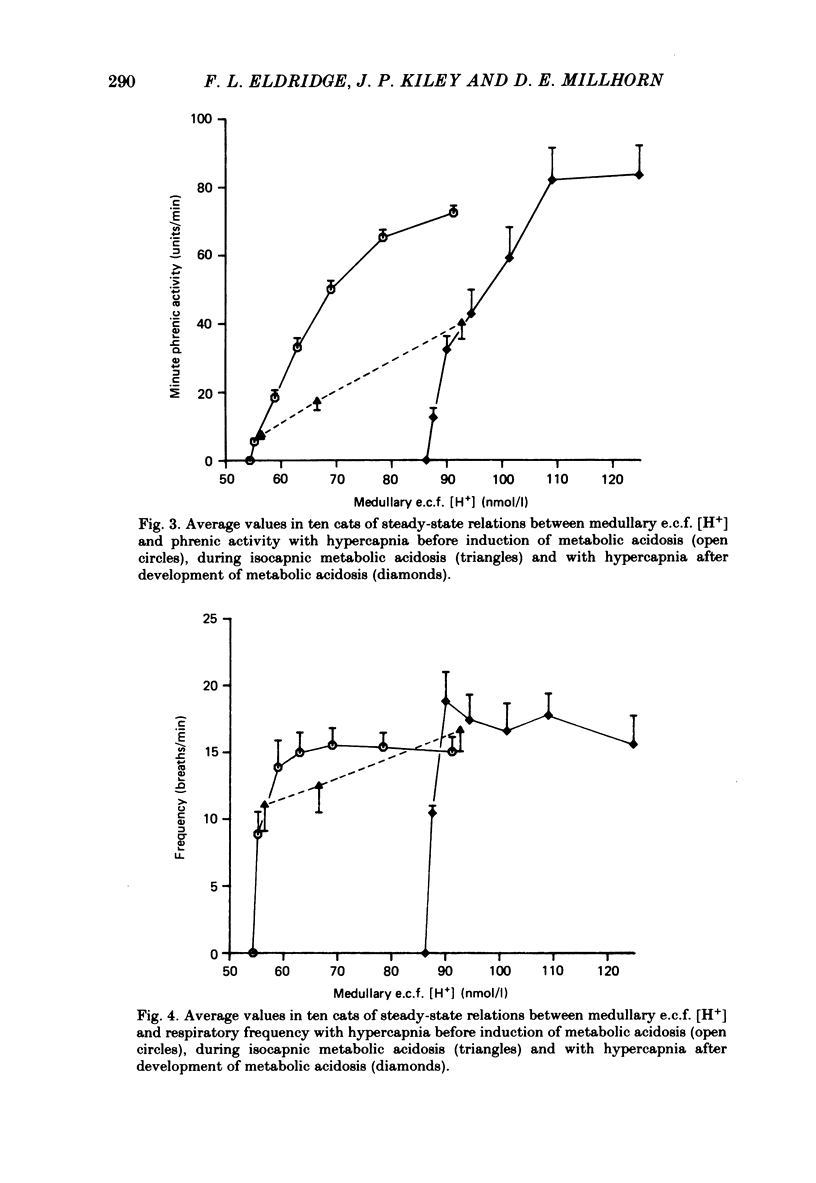
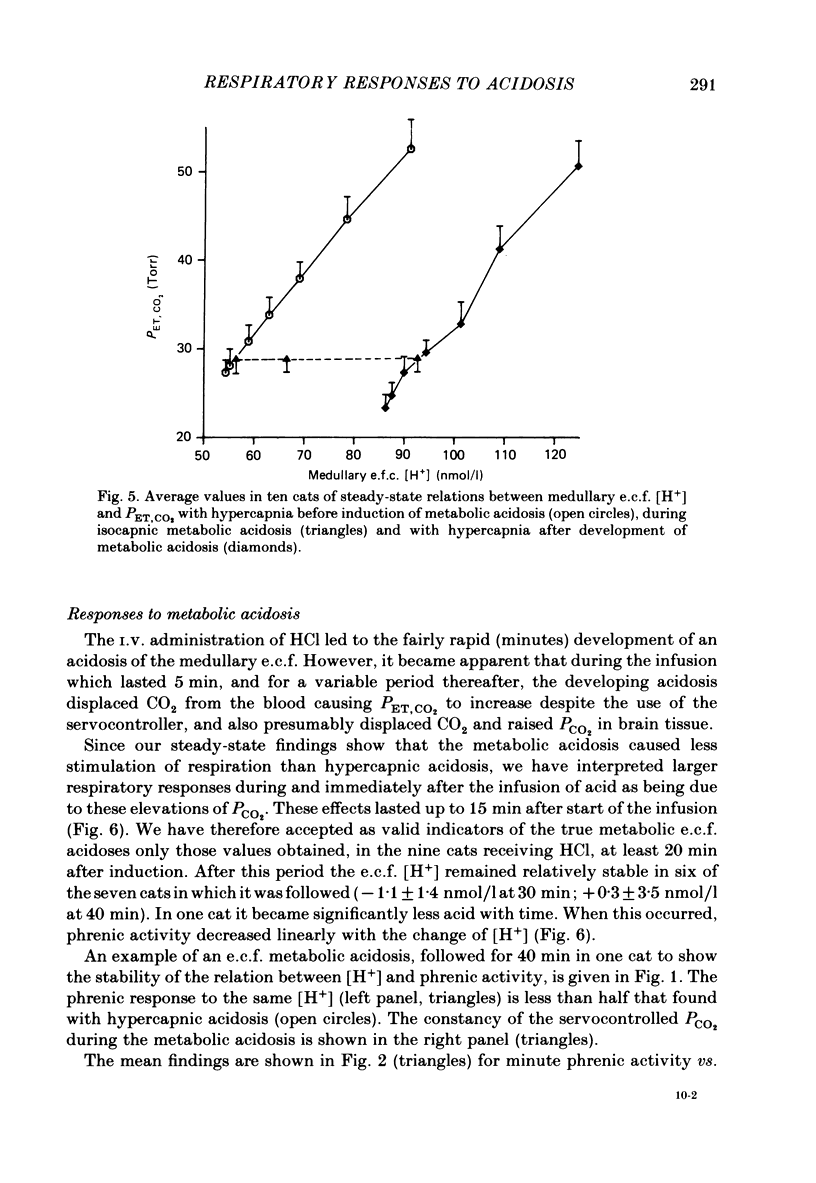
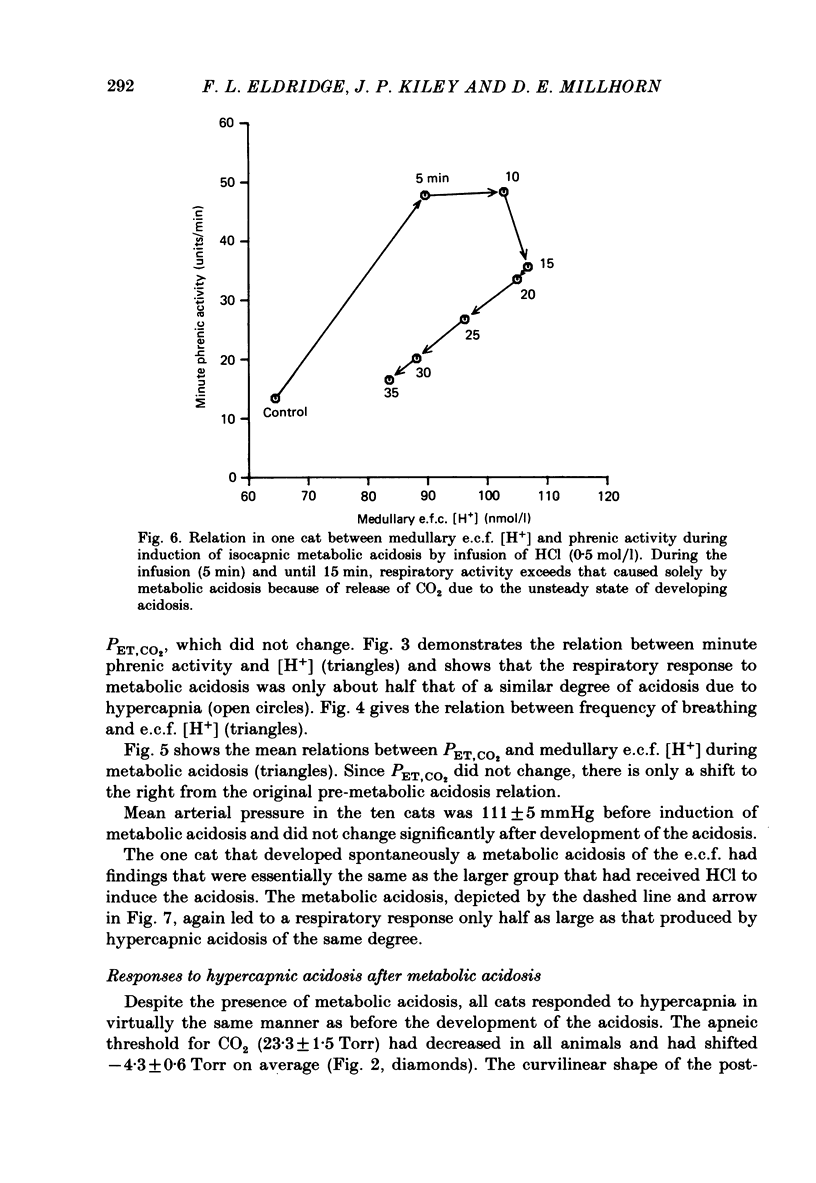
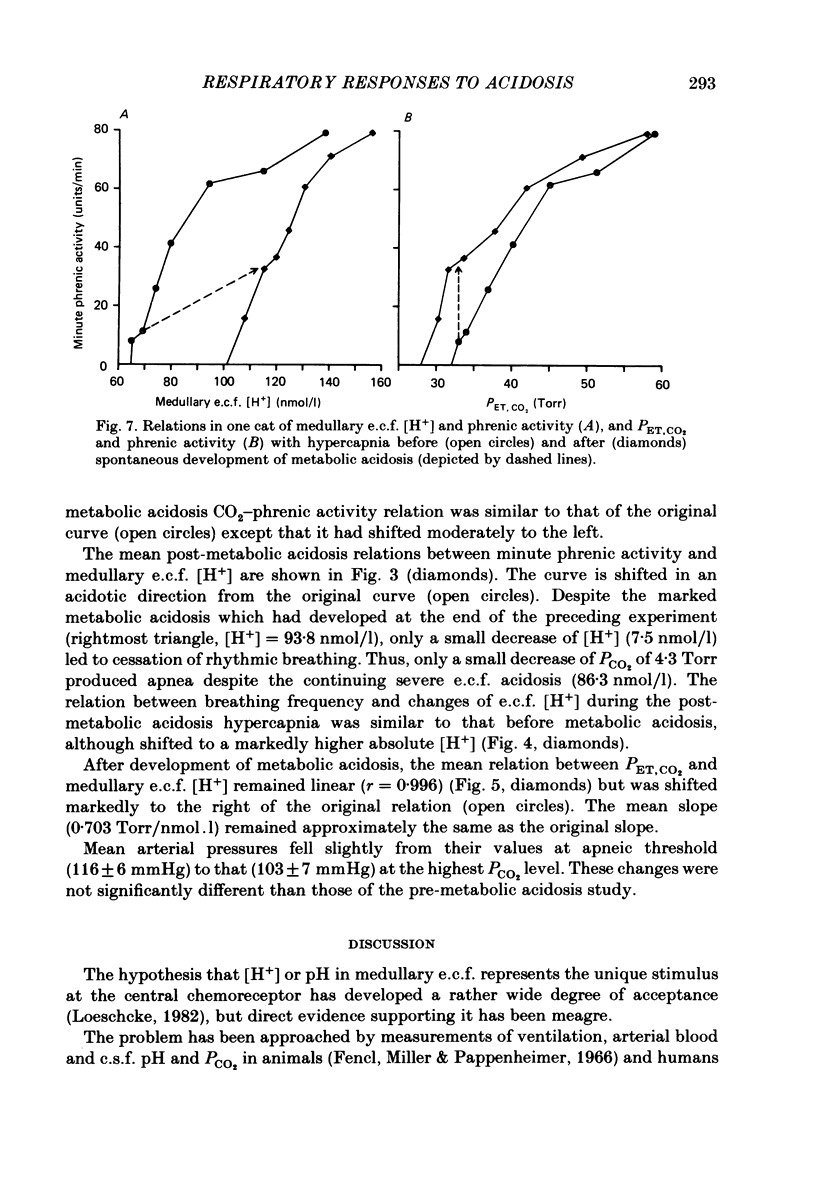
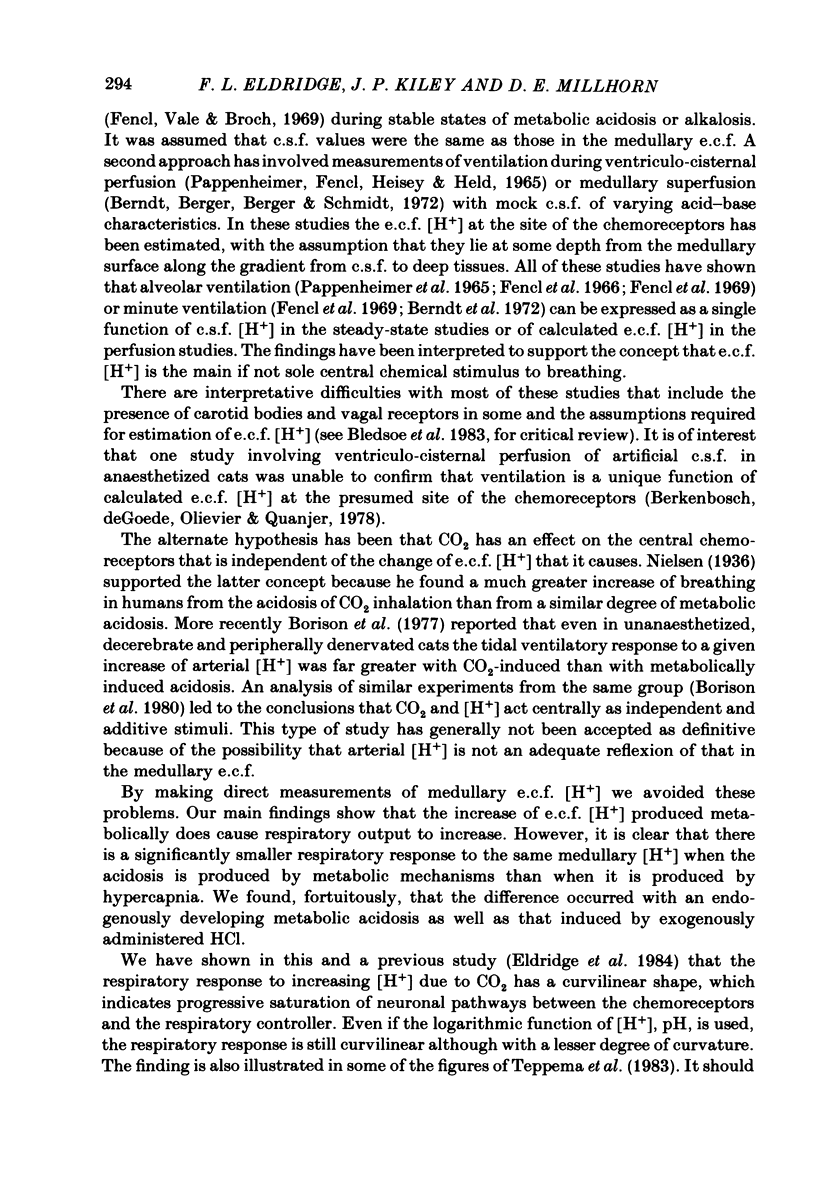
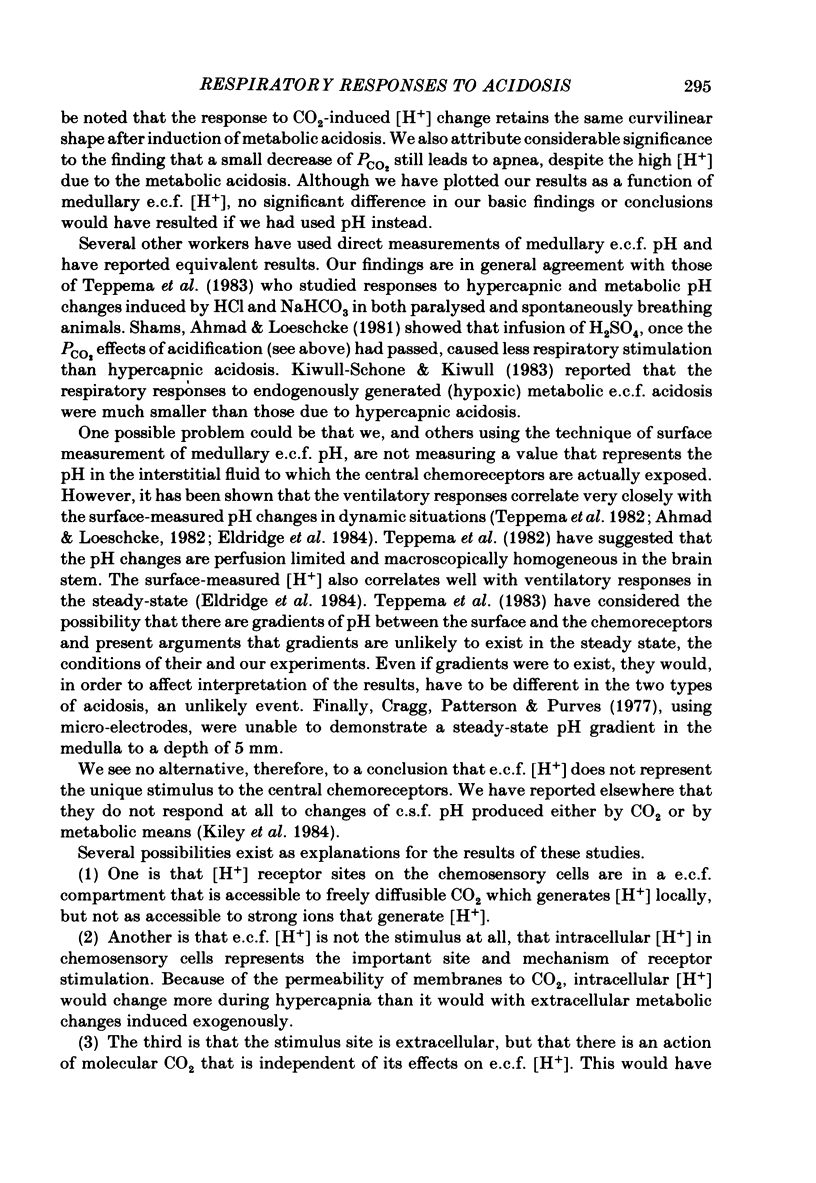
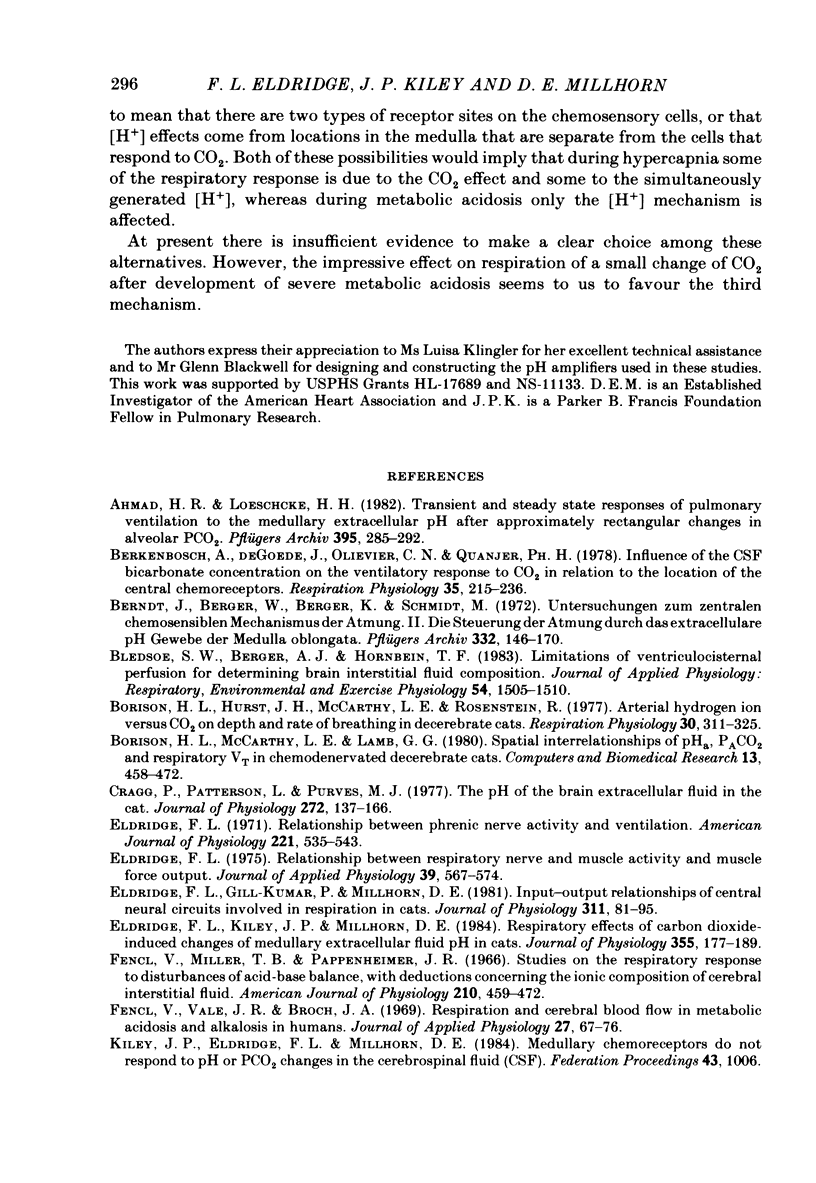
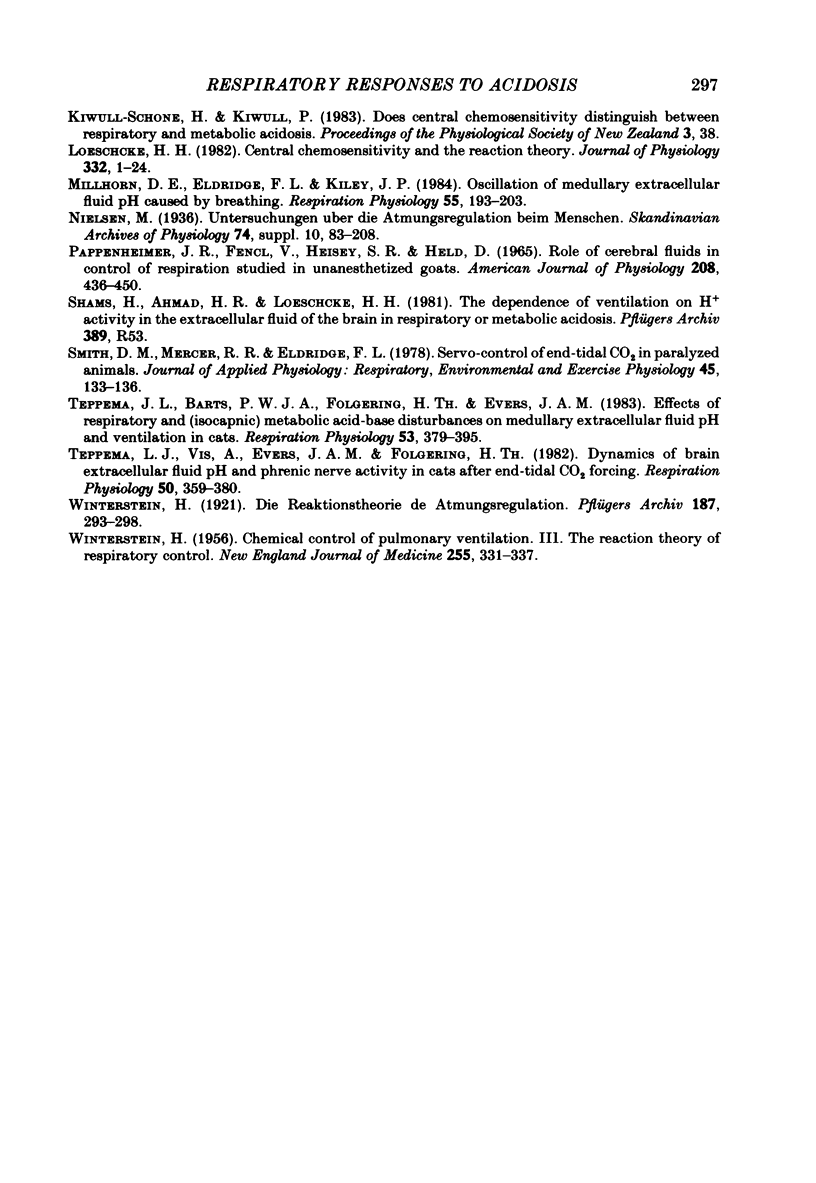
Selected References
These references are in PubMed. This may not be the complete list of references from this article.
- Ahmad H. R., Loeschcke H. H. Transient and steady state responses of pulmonary ventilation to the medullary extracellular pH after approximately rectangular changes in alveolar PCO2. Pflugers Arch. 1982 Dec;395(4):285–292. doi: 10.1007/BF00580791. [DOI] [PubMed] [Google Scholar]
- Berkenbosch A., de Goede J., Olievier C. N., Quanjer P. H., Perk J. H., Philips L., Rancuret M. M. Influence of the CSF bicarbonate concentration on the ventilatory response to CO2 in relation to the location of the central chemoreceptors. Respir Physiol. 1978 Nov;35(2):215–236. doi: 10.1016/0034-5687(78)90023-3. [DOI] [PubMed] [Google Scholar]
- Berndt J., Berger W., Berger K., Schmidt M. Untersuchungen zum zentralen chemosensiblen Mechanismus der Atmung. II. Die Steuerung der Atmung durch das extracelluläre pH im Gewebe der Medulla oblongata. Pflugers Arch. 1972;332(2):146–170. doi: 10.1007/BF00589090. [DOI] [PubMed] [Google Scholar]
- Bledsoe S. W., Berger A. J., Hornbein T. F. Limitations of ventriculocisternal perfusion for determining brain interstitial fluid composition. J Appl Physiol Respir Environ Exerc Physiol. 1983 Jun;54(6):1505–1510. doi: 10.1152/jappl.1983.54.6.1505. [DOI] [PubMed] [Google Scholar]
- Borison H. L., Hurst J. H., McCarthy L. E., Rosenstein R. Arterial hydrogen ion versus CO2 on depth and rate of breathing in decerebrate cats. Respir Physiol. 1977 Aug;30(3):311–325. doi: 10.1016/0034-5687(77)90038-x. [DOI] [PubMed] [Google Scholar]
- Borison H. L., McCarthy L. E., Lamb G. C. Spatial interrelationship of pHa PACO2 and respiratory VT in chemodenervated decerebrate cats. Comput Biomed Res. 1980 Oct;13(5):458–472. doi: 10.1016/0010-4809(80)90043-9. [DOI] [PubMed] [Google Scholar]
- Cragg P., Patterson L., Purves M. J. The pH of brain extracellular fluid in the cat. J Physiol. 1977 Oct;272(1):137–166. doi: 10.1113/jphysiol.1977.sp012038. [DOI] [PMC free article] [PubMed] [Google Scholar]
- Eldridge F. L., Gill-Kumar P., Millhorn D. E. Input-output relationships of central neural circuits involved in respiration in cats. J Physiol. 1981 Feb;311:81–95. doi: 10.1113/jphysiol.1981.sp013574. [DOI] [PMC free article] [PubMed] [Google Scholar]
- Eldridge F. L., Kiley J. P., Millhorn D. E. Respiratory effects of carbon dioxide-induced changes of medullary extracellular fluid pH in cats. J Physiol. 1984 Oct;355:177–189. doi: 10.1113/jphysiol.1984.sp015413. [DOI] [PMC free article] [PubMed] [Google Scholar]
- Eldridge F. L. Relationship between phrenic nerve activity and ventilation. Am J Physiol. 1971 Aug;221(2):535–543. doi: 10.1152/ajplegacy.1971.221.2.535. [DOI] [PubMed] [Google Scholar]
- Eldridge F. L. Relationship between respiratory nerve and muscle activity and muscle force output. J Appl Physiol. 1975 Oct;39(4):567–574. doi: 10.1152/jappl.1975.39.4.567. [DOI] [PubMed] [Google Scholar]
- Fencl V., Miller T. B., Pappenheimer J. R. Studies on the respiratory response to disturbances of acid-base balance, with deductions concerning the ionic composition of cerebral interstitial fluid. Am J Physiol. 1966 Mar;210(3):459–472. doi: 10.1152/ajplegacy.1966.210.3.459. [DOI] [PubMed] [Google Scholar]
- Fencl V., Vale J. R., Broch J. A. Respiration and cerebral blood flow in metabolic acidosis and alkalosis in humans. J Appl Physiol. 1969 Jul;27(1):67–76. doi: 10.1152/jappl.1969.27.1.67. [DOI] [PubMed] [Google Scholar]
- Loeschcke H. H. Central chemosensitivity and the reaction theory. J Physiol. 1982 Nov;332:1–24. doi: 10.1113/jphysiol.1982.sp014397. [DOI] [PMC free article] [PubMed] [Google Scholar]
- Millhorn D. E., Eldridge F. L., Kiley J. P. Oscillations of medullary extracellular fluid pH caused by breathing. Respir Physiol. 1984 Feb;55(2):193–203. doi: 10.1016/0034-5687(84)90022-7. [DOI] [PubMed] [Google Scholar]
- PAPPENHEIMER J. R., FENCL V., HEISEY S. R., HELD D. ROLE OF CEREBRAL FLUIDS IN CONTROL OF RESPIRATION AS STUDIED IN UNANESTHETIZED GOATS. Am J Physiol. 1965 Mar;208:436–450. doi: 10.1152/ajplegacy.1965.208.3.436. [DOI] [PubMed] [Google Scholar]
- Smith D. M., Mercer R. R., Eldridge F. L. Servo control of end-tidal CO2 in paralyzed animals. J Appl Physiol Respir Environ Exerc Physiol. 1978 Jul;45(1):133–136. doi: 10.1152/jappl.1978.45.1.133. [DOI] [PubMed] [Google Scholar]
- Teppema L. J., Barts P. W., Folgering H. T., Evers J. A. Effects of respiratory and (isocapnic) metabolic arterial acid-base disturbances on medullary extracellular fluid pH and ventilation in cats. Respir Physiol. 1983 Sep;53(3):379–395. doi: 10.1016/0034-5687(83)90127-5. [DOI] [PubMed] [Google Scholar]
- Teppema L. J., Vis A., Evers J. A., Folgering H. T. Dynamics of brain extracellular fluid pH and phrenic nerve activity in cats after end-tidal CO2 forcing. Respir Physiol. 1982 Dec;50(3):359–380. doi: 10.1016/0034-5687(82)90029-9. [DOI] [PubMed] [Google Scholar]
- WINTERSTEIN H. Chemical control of pulmonary ventilation. III. The reaction theory of respiratory control. N Engl J Med. 1956 Aug 16;255(7):331–337. doi: 10.1056/NEJM195608162550705. [DOI] [PubMed] [Google Scholar]


